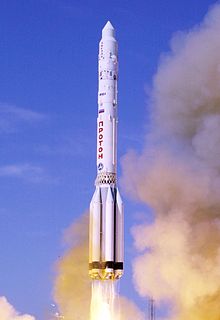
Cape Canaveral Space Force Station (CCSFS) is an installation of the United States Space Force's Space Launch Delta 45, located on Cape Canaveral in Brevard County, Florida.

The PGM-17A Thor was the first operational ballistic missile of the United States Air Force (USAF). Named after the Norse god of thunder, it was deployed in the United Kingdom between 1959 and September 1963 as an intermediate-range ballistic missile (IRBM) with thermonuclear warheads. Thor was 65 feet (20 m) in height and 8 feet (2.4 m) in diameter. It was later augmented in the U.S. IRBM arsenal by the Jupiter.

Delta is an American versatile family of expendable launch systems that has provided space launch capability in the United States since 1960. Japan also launched license-built derivatives from 1975 to 1992. More than 300 Delta rockets have been launched with a 95% success rate. Only the Delta IV Heavy rocket remains in use as of November 2020. Delta rockets have stopped being manufactured in favor of Vulcan.

Space Launch Complex 17 (SLC-17), previously designated Launch Complex 17 (LC-17), was a launch site at Cape Canaveral Air Force Station (CCAFS), Florida used for Thor and Delta launch vehicles launches between 1958 and 2011.
The Delta G, or Thor-Delta G was an American expendable launch system used to launch two biological research satellites in 1966 and 1967. It was a member of the Delta family of rockets.

Thor was a US space launch vehicle derived from the PGM-17 Thor intermediate-range ballistic missile. The Thor rocket was the first member of the Delta rocket family of space launch vehicles. The last launch of a direct derivative of the Thor missile occurred in 2018 as the first stage of the final Delta II.

The Thor-Ablestar, or Thor-Able-Star, also known as Thor-Epsilon was an early American expendable launch system consisting of a PGM-17 Thor missile, with an Ablestar upper stage. It was a member of the Thor family of rockets, and was derived from the Thor-Able.

The Thor DSV-2U or Thor LV-2F Star-37XE Star-37S-ISS was an American expendable launch system used to launch five DMSP weather satellites between 1976 and 1980. It was a member of the Thor family of rockets, and a derivative of the Thor DSV-2.

The Thor-Delta, also known as Delta DM-19 or just Delta was an early American expendable launch system used for 12 orbital launches in the early 1960s. A derivative of the Thor-Able, it was a member of the Thor family of rockets, and the first member of the Delta family.
The Delta A, or Thor-Delta A was an American expendable launch system used to launch two Explorer spacecraft in October 1962. A derivative of the Thor-Delta, it was a member of the Delta family of launch vehicles. The Thor-Delta itself was a Thor booster with an Able second stage and Altair third stage.

The Delta B, or Thor-Delta B was an American expendable launch system used for nine orbital launches between 1962 and 1964. A derivative of the Thor-Delta, it was a member of the Delta family of rockets.

The Delta C, or Thor-Delta C was an American expendable launch system used for thirteen orbital launches between 1963 and 1969. It was a member of the Delta family of rockets.
The Delta J, or Thor-Delta J was an American expendable launch system of the late 1960s. Only one was launched, with the Explorer 38 spacecraft. It was a member of the Delta family of rockets.

The Delta M or Thor-Delta M was an American expendable launch system used for thirteen orbital launches between 1968 and 1971. It was a member of the Delta family of rockets.

The Proton-K, also designated Proton 8K82K after its GRAU index, 8K82K, was a Russian, previously Soviet, carrier rocket derived from the earlier Proton. It was built by Khrunichev, and launched from sites 81 and 200 at the Baikonur Cosmodrome in Kazakhstan.

Launch Complex 18 (LC-18) is a launch complex at the Cape Canaveral Space Force Station, Florida that was active during the late 1950s and early 1960s. It was used by Viking, Vanguard, Thor and Scout rockets. The complex consists of two launch pads, LC-18A, which was originally built by the US Navy for the Vanguard rocket, and LC-18B, which was originally by the US Air Force used for tests of the PGM-17 Thor missile.

The NOTS-EV-2 Caleb, also known as NOTS-500, Hi-Hoe and SIP was an expendable launch system, which was later used as a sounding rocket and prototype anti-satellite weapon. It was developed by the United States Navy's Naval Ordnance Test Station (NOTS) as a follow-up to the NOTS-EV-1 Pilot, which had been abandoned following ten launches officially classified as failed missions. Two were launched in July and October 1960, before the cancellation of the project. Following cancellation, two leftover Calebs were used in the Satellite Interceptor Program (SIP), while three more were used as sounding rockets, under the designation Hi-Hoe. These derivatives flew until July 1962, when the Hi-Hoe made its final flight.














